Maximizing Efficiency with Dual Monitor Laptops

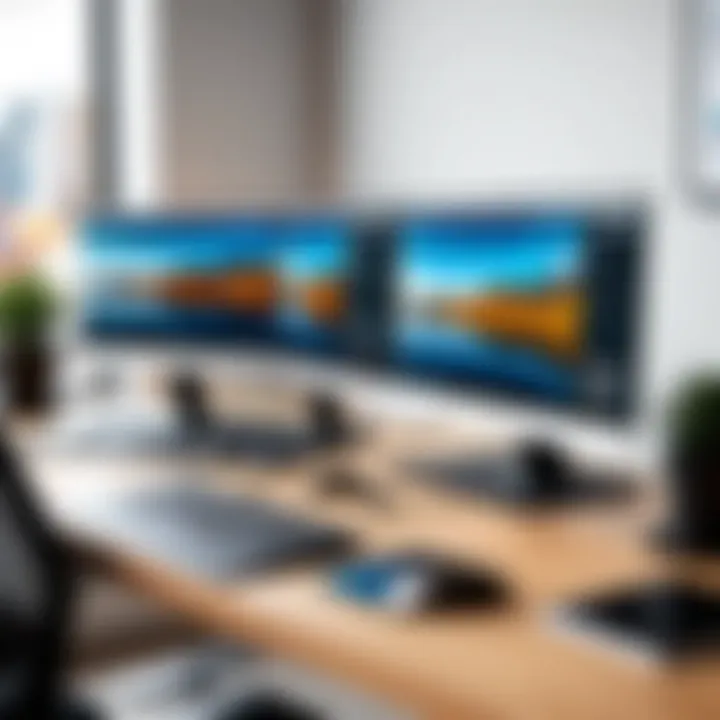
Intro
In today’s fast-paced, tech-savvy environment, many users have discovered the benefits of utilizing dual monitors with their laptops. This setup not only enlarges your workspace but enhances efficiency, allowing for a seamless workflow. You might be wondering how to get the most out of such an arrangement. Fear not! This guide will walk you through the ins and outs of setting up, configuring, and optimizing your dual monitor setup on laptops.
As we dive into the intricacies of this setup, we will blend practical advice with essential technical details. This way, whether you're a creative looking to manage design tools more effectively, a data analyst needing extra screen real estate for spreadsheets, or simply someone who likes to binge-watch videos while going through emails, there’s something here for everyone. Let’s get started and transform your laptop experience!
Preamble to Dual Monitor Use
In today's fast-paced world of work and play, many folks are discovering that a single screen just doesn't cut it anymore. Setting up a dual monitor system can be a game changer. It brings a level of efficiency and organization that makes multitasking feel less like juggling flaming torches and more like smoothly gliding on ice. Dual monitors give users the gift of additional screen real estate, allowing them to spread out their tasks and run applications side by side without constantly switching back and forth. The beauty of such a setup lies in its versatility—whether you're coding, writing reports, or just binge-watching your favorite series, having those extra pixels can make a significant difference.
Defining Dual Monitor Setup
At its core, a dual monitor setup involves connecting two displays to a single laptop or computer. Think of it as expanding your desktop into a wider, more interactive canvas. It's not just about tacking on another screen; it’s about maximizing the potential of your workspace.
When defining a dual monitor configuration, you might consider various arrangements:
- Extended Mode: Here, each monitor acts as part of a larger desktop. You can drag windows from one screen to the other seamlessly.
- Mirrored Mode: Both screens display the same content. This is often used for presentations, allowing an audience to see what you see.
- Primary and Secondary Displays: You can designate one monitor as the primary (where your main tasks happen) and the other as secondary (for supplementary tools and information).
Choosing a setup that fits your workflow is crucial, and knowing the distinctions helps with that.
Benefits of Utilizing Dual Monitors
The advantages of using dual monitors can't be overstated. Not only does dual monitor use boost productivity, but it can also enhance focus and organization. Here’s a closer look at some of the real-world benefits:
- Increased Productivity: Studies have shown that using dual monitors can increase productivity by up to 30%. Think of how many more emails, documents, or data sheets you can view all at once!
- Better Multitasking: Switching between tabs and applications can be a bottleneck. With more screens, you can keep your email open in one spot while editing documents in another.
- Enhanced Collaboration: In a team environment, having multiple displays can allow for easier sharing and collaboration. You can reference one document while discussing another, making teamwork much smoother.
- Simplified Content Management: For creatives and content producers, dual monitors offer the luxury of viewing editing software on one screen while displaying the output on the other.
"Having more screen space is akin to having a larger desk; more room allows for better organization and workflow."
Considering these benefits, it’s clear that investing in a dual monitor setup isn’t just a nice-to-have; it can substantially elevate your productivity and effectiveness in daily tasks. The right approach to configuring this technology can unlock an entirely new level of efficiency.
Understanding Laptop Compatibility
When it comes to getting the most out of dual monitors with laptops, understanding compatibility is not just a checkbox on a list—it's the backbone of a successful setup. Many users fail to realize that not every laptop can easily connect to two external screens. Factors such as hardware specifications and available ports play a crucial role in determining whether your laptop can handle a dual monitor setup.
Getting familiar with these elements can save you from a world of frustration down the line. Imagine you’ve spent time and money picking out monitors only to find out that your laptop doesn’t support them. This not only wastes resources but can also derail your productivity goals, which is likely why you were considering a dual monitor setup in the first place.
Hardware Requirements for Dual Monitors
Before diving deep into the world of connections and cables, it’s smart to assess what your laptop has under the hood. The two main components that dictate your laptop's ability to support dual monitors are its graphics card and processing power. Not all laptops come equipped with the necessary hardware to run multiple displays smoothly.
To figure out if your machine makes the cut, here are some points to consider:
- Graphics Card: Look for dedicated graphics cards, like those from NVIDIA or AMD, as integrated graphics might struggle with high-resolution displays.
- RAM: A laptop with less than 8 GB of RAM may face challenges when multitasking across multiple screens demanding high resources.
- Processor: An efficient processor can affect performance. Ideally, you would want a multi-core processor that can juggle tasks across screens with ease.
Be sure to check your laptop’s specifications, either via the manufacturer’s website or through system settings, to see if it meets these requirements.
Ports and Connectors: What You Need to Know
Equipped with the right hardware, the next step is understanding what ports your laptop offers. This often overlooked aspect can make or break the setup experience.
Here are the common ports and connectors you’re likely to encounter:
- HDMI (High-Definition Multimedia Interface): Widely used, this port can carry high-definition video and audio. In most cases, it’s plug-and-play, making it a favorite.
- DisplayPort: This port is particularly favored by many monitors for its ability to daisy chain multiple displays. If you’re planning to connect several screens, keep an eye out for this one.
- USB-C: This multi-purpose connector is becoming incredibly popular. If you have a newer laptop, it might support video output, allowing you to connect to monitors easily.
- VGA and DVI: These are older standards. While still found on some devices, they are often not included in fewer modern laptops.
They say, knowing your tools is half the battle, and in this case, knowing your ports opens up a world of possibilities for your dual monitor configuration.
Finally, it's essential to consult your laptop's manual or website for specific instructions on how to interpret its connectivity options. A dual monitor setup can offer a streamlined approach to productivity, but first, you need to ensure that your laptop is compatibility-friendly.
Connecting External Monitors
Connecting external monitors to a laptop can significantly enhance the user experience, transforming a simple workspace into a multitasking powerhouse. Many professionals and tech enthusiasts discover that having that extra screen can streamline workflows, improve focus, and ultimately boost productivity. When considering how best to connect these monitors, it's essential to grasp a few key elements and their available benefits, which we'll explore further.
Choosing the Right Cables
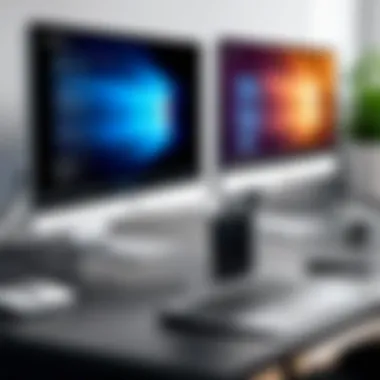
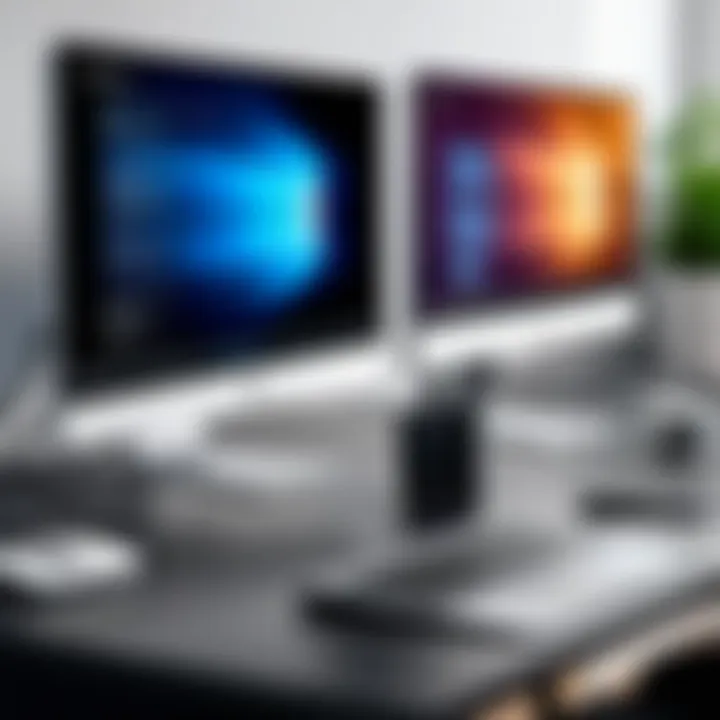
Selecting the correct type of cable is crucial, as it determines not just connectivity, but also the quality of the display. Here are a few common options:
- HDMI (High-Definition Multimedia Interface): Widely favored for its ability to transmit both high-definition video and audio through a single cable. Virtually all modern monitors and laptops support HDMI.
- DisplayPort: Often found in gaming monitors and high-performance displays, it offers better bandwidth to support higher resolutions and refresh rates.
- VGA (Video Graphics Array): An older standard that still works well for many setups; however, it's limited to lower resolutions and doesn't provide audio output.
- DVI (Digital Visual Interface): This is another option for connecting monitors. It’s not as common anymore but can deliver better quality than VGA.
It’s crucial also to check your laptop and monitor specifications. Ensure compatibility of ports before making a purchase; there’s no point in investing in cables if they don’t fit your devices. If your laptop has a Thunderbolt 3 port, for instance, an adapter that converts to HDMI or DisplayPort can be a life-saver.
Step-by-Step Connection Process
Connecting external monitors is easier than pie if you follow a systematic approach. Here’s how you can do it:
- Gather Your Materials: Before starting, make sure you have your cables on hand. Check that you have enough length for your setup.
- Power Down: It’s always a good practice to turn off your laptop before connecting new monitors to avoid any potential hardware glitches.
- Connect the Cables: Plug one end of the cable into your laptop’s output port and the other into your monitor. Ensure the connection is snug.
- Power On: Turn on your monitor first, then your laptop. This order helps in detection.
- Detection: Most laptops will automatically recognize the monitor. If not, you can usually press the Windows key + P to select how you want the screens to function—extend, duplicate, or second screen only.
- Configure Settings: Finally, dive into your display settings to adjust resolution and arrange the monitors. This allows you to set the primary monitor and adjust orientations as needed.
By following these steps, you not only ensure a smooth connection but also lay the groundwork for configuring your monitors effectively. Remember that each connection may vary slightly based on your specific laptop and monitor models, so don't hesitate to consult your manufacturer’s guide if you find yourself stuck.
"A dual monitor setup isn't just about having more screen real estate; it's about transforming the way you work."
With the right cables and a clear connection process, you're already well on your way to an optimized dual monitor setup.
Configuring Display Settings
Configuring display settings is vital for maximizing the utility of your dual monitor setup. This process isn’t merely a checklist but rather an art of balancing and fine-tuning the display characteristics to fit individual preferences and enhance productivity. When done correctly, it can significantly improve workflow, reduce strain and elevate the overall user experience. Let's break down the essential elements involved in configuring your display settings.
Accessing Display Settings on Different OS
Accessing display settings can vary notably depending on the operating system you’re using. Here’s a clear overview:
- Windows: Right-click on the desktop and select Display settings. Here, you can view both monitors, rearrange them, and adjust resolutions. Windows makes it pretty straightforward.
- macOS: Go to the Apple menu and select System Preferences, followed by Displays. With macOS, you can seamlessly organize your displays by dragging them around.
- Linux: On distributions like Ubuntu, access the Settings option, choose Displays, and here you can manage your monitors. A bit more tech-savvy than the rest, but still, quite user-friendly!
Each OS has its quirks, but the common thread is that getting there is relatively simple, won't take much time. Knowing how to access your settings can save you the headache later.
Arranging Your Monitors Correctly
A proper arrangement of your monitors is crucial. If you think about it, consider how you transition between them. The layout can either smooth sailing or bumpy roads.
To set your monitors up in a functional manner, think about the following:
- Physical Alignment: Ensure your monitors are at the same height to avoid neck strain. It can be quite a nuisance if one is perched higher than the other.
- Digital Arrangement: In your display settings, arrange the digital representation of your monitors accurately. Drag the monitor icons to reflect their actual physical alignment. This ensures seamless cursor movement, which can be noticeably jarring if misaligned.
- Orientation: Decide whether you want your displays in landscape or portrait mode. For coding or reading long documents, portrait can be a game changer.
Aligning both the physical and digital elements of your setup directly impacts your productivity. Negligence here can lead to frustrations in the long run.
Setting Optimal Resolutions
The resolution settings might be overlooked, but they serve a crucial role in your viewing experience. Each monitor connected to your laptop can display the best visual details if set correctly.
Here’s how to effectively set the optimal resolutions for your monitors:
- Know the Monitor’s Natives: Each monitor comes with a native resolution — this is the maximum number of pixels it can display clearly. Check this in the user manual or online specs.
- Adjust in Settings: After knowing the native resolution, head back to the display settings. Select each monitor and adjust the resolution accordingly. Windows and macOS often suggest the best resolution for you based on the connected monitors.
- Scaling Options: Sometimes, even at the native resolution, text and icons might appear too small. Use the scaling options available to customize your experience without compromising clarity.
- Test Adjustments: After making changes, take a moment to test them out. Open various applications and notice if anything feels off. Small tweaks here can lead to a more comfortable and enjoyable interface.
Getting these resolutions right can save your eyes from strain and increase your focus, impacting every task you handle.
Choosing the right display settings is not just a technical requirement; it can greatly shape how effectively you use your dual monitor setup.
Taking the time to configure display settings may seem like a minor issue, but it’s an essential step that can vastly change your work and leisure routines. Emphasizing the importance of this stage is pressing, as a well-optimized dual monitor setup means better productivity, enhanced focus, and overall improved user satisfaction.
Utilizing Dual Monitors for Enhanced Productivity
In today’s fast-paced digital landscape, the utilization of dual monitors can significantly amp up your productivity. It’s not just about having an extra screen; it’s about creating an environment where information flows seamlessly, allowing you to grasp details without constantly toggling between windows. Many professionals can attest to the myriad of benefits that arise from having a dual monitor setup — whether you are into coding, graphic design, or just multitasking between spreadsheets and communication tools.
Effective Multitasking Techniques
The art of multitasking transforms entirely with dual monitors. With one screen dedicated to your primary task and the second acting as a support system, you can juggle multiple duties without feeling bogged down. Here are a few specific techniques to leverage this setup effectively:
- Dedicated Screens for Different Tasks: Assign one monitor for tasks like document editing, while the other can show reference materials or communication apps like Slack or Discord. Think of it as having a personal assistant, always at your side, ready with the info you need.
- Using Virtual Desktops: If your operating system supports it, use virtual desktops on one monitor while keeping everyday apps on the other. It’s like having multiple rooms in your office, where each room serves a different purpose.
- Side-by-Side Comparison: For tasks that require close inspection, place two documents side by side to evaluate changes in real-time. You’ll find that reviewing and editing becomes less tedious, more like a back-and-forth conversation rather than a complex puzzle.
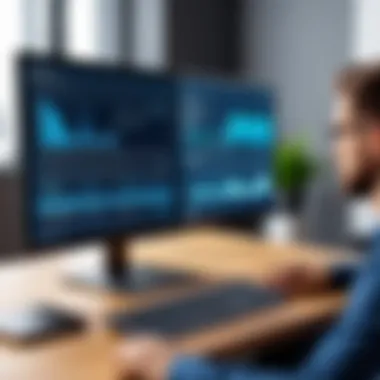
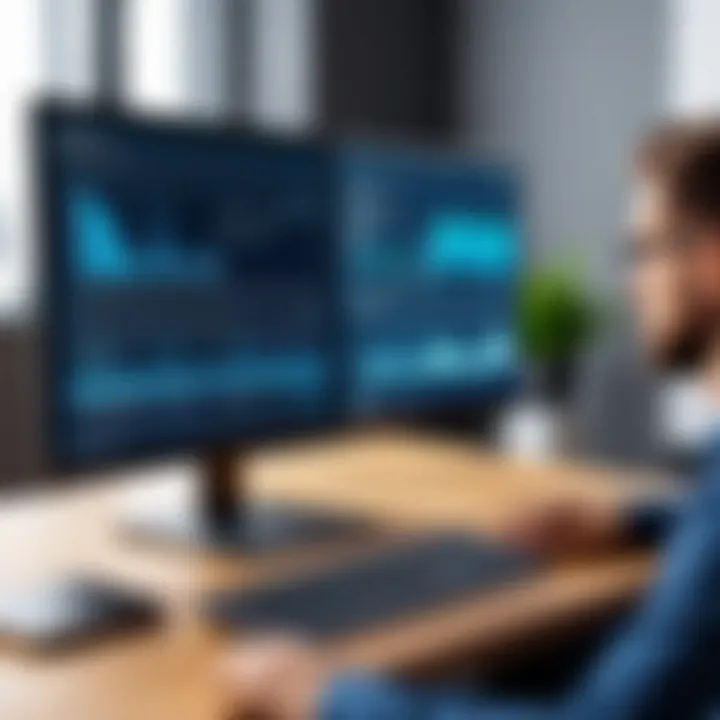
"The right setup can turn chaos into clarity, helping you maintain your focus amidst distractions."
Application Layouts That Maximize Screen Space
Beyond just utilizing two screens, how you layout your applications can make a tremendous difference. Here are suggestions to get those creative juices flowing:
- Stacked Layout: Use one screen for a larger application window while relegating smaller or secondary apps to the side. For instance, you could have your video editor open full-screen on one monitor while using the other for social media management.
- Tile Your Windows: Instead of having apps overlap, arrange them to occupy different quadrants of your screens. Many operating systems allow you to drag windows to the edges for automatic tiling. It’s like having a perfectly organized desk, where each tool is easily accessible yet separated from the clutter.
- Utilizing Browser Features: For web-based work, consider the use of multiple browser profiles or tabs on one monitor. It allows you to segregate work tasks; for example, research can stay on one side while you compile notes on the other. It’s similar to having different notebooks for various subjects; it keeps your focus sharp and your workspace tidy.
In summary, the integration of dual monitors doesn’t merely enhance your workspace; it revolutionizes how effectively you can work. Implementing these techniques can enable you to harness the full power of your setup, allowing for a workflow that feels intuitive and responsive. With a little planning, your dual monitors can transform from a mere tech upgrade into an essential productivity tool.
Common Issues and Troubleshooting
When diving into the world of dual monitor setups, it’s important to realize that not everything always works smoothly. This section sheds light on common hitches you might encounter, making it clear that troubleshooting is just as crucial as the initial setup. Recognizing and resolving these issues can save time and frustration, particularly for those relying on dual monitors for work or entertainment.
Display Not Detected
Imagine you've set up your external monitor, only to find that your laptop in some mysterious way doesn’t recognize it. The silence of a blank screen can be particularly disheartening. This issue can occur due to various factors, including incompatible cables or incorrect display settings. First off, ensure all connections are secure. Sometimes a loose cable is the sneaky culprit here. If that’s all good, try performing these steps:
- Check Connections: Make sure that each cable is firmly plugged into both laptop and monitor.
- Input Source Settings: On your monitor, cycle through the input sources—sometimes your display is set to look for signals from the wrong source.
If the display is still not being detected after checking these, it could mean a deeper dive is needed. Rebooting your laptop can sometimes work wonders, resetting the communication between devices.
Screen Flickering Problems
Screen flickering can be annoying, right? Whether you’re trying to track stock prices or binge-watch your favorite show, a flickering screen disrupts everything. Typically, this could stem from issues with refresh rates, resolution settings, or even faulty cables. To tackle this:
- Adjust Refresh Rate: Go to display settings and check the refresh rate settings. You might find that adjusting this to match your monitor's recommended specs resolves the issue.
- Inspect Cables: Look over the cables again. If they are damaged, replacing them might solve more problems than you think.
Another handy tip is to ensure that your graphics driver is up to date. Sometimes a small update can prevent the headaches you might not even have realized were coming your way.
Driver Issues and Solutions
Drivers can be likened to the bridge connecting software to hardware. If your laptop is having a tough time recognizing your dual monitor setup, it’s often down to outdated or corrupted drivers. Here’s how to navigate these driver-related woes:
- Identify Graphics Card: Know which graphics card your laptop has. On Windows, you can find this information in the Device Manager under ‘Display Adapters.’
- Download the Latest Drivers: Head over to the manufacturer's website (NVIDIA, AMD, Intel) to grab the latest drivers. Install them following the instructions provided.
- Restart and Reconnect: Restart your laptop after updates. Once it's booted, try reconnecting your external monitors.
Troubleshooting isn’t just a necessary evil. Mastering this aspect of your dual monitor setup can actually elevate your experience. The goal is to turn potential stumbling blocks into stepping stones. Stay on top of updates and settings, and you’ll find the dual-screen world can be incredibly rewarding.
Advanced Dual Monitor Features
When it comes to maximizing a dual monitor setup on laptops, diving into advanced features can elevate your experience from mere convenience to remarkable functionality. These features unlock potential that tap into a range of applications, suited for both work and play, catering specifically to tech-savvy individuals who demand more from their workspace. Understanding the specifics of these features empowers you to tailor your setup to fit personal needs and preferences. Not everybody sees dual screens as a luxury; many tech enthusiasts view it as a vital necessity.
Using Different Display Modes
One of the most significant aspects of utilizing dual monitors effectively is understanding and switching between different display modes. The common options—extend, duplicate, and second screen only—each serve a purpose that can dramatically change user experience.
- Extend: This mode stretches your desktop across both screens. It allows users to move applications from one screen to another seamlessly. Think of it as creating a larger canvas; tasks can be divided across monitors, enabling multitasking without feeling cramped.
- Duplicate: In this mode, both screens display the same content. It’s handy for presentations or sharing your screen in collaborative settings. Everyone can see the same thing, making it ideal when you’re explaining or demonstrating something to others.
- Second Screen Only: This mode turns off your laptop’s display and uses only the external monitor. This is useful if you're using a larger external monitor to do resource-intensive work, allowing you to focus only on that extensive screen.
"Different display modes open up a world of possibilities—it's not just about seeing more but also about doing more."
Switching between these modes is usually a simple keyboard shortcut, like Windows + P on a Windows laptop, which brings up options at the flick of a wrist. It’s about being agile, adapting your display configuration to tackle varying tasks throughout the day.
Gaming and Entertainment on Dual Monitors
For gamers, the excitement of dual monitor setups extends beyond just more screen real estate. Dual monitors can create an immersive gaming experience that pulls you deeper into the gameplay. Players can keep track of chat feeds or strategies on one screen while immersing themselves in the action on another. But it’s not just about gaming; entertainment takes on a different flavor too when using dual setups.
- Enhanced Gaming Experience: Games that support widescreen formats gloriously utilize both screens. Titles like Microsoft Flight Simulator or World of Warcraft can feel more engaging when you see your environment encased within two displays—it's akin to viewing a panoramic movie.
- Multitasking While Gaming: With chat clients open on one monitor, gamers can interact without missing a heartbeat of what happens in-game. Whether it’s strategizing with teammates or watching live streams while playing, dual monitors come to the rescue.
- Streaming and Content Creation: For those who wish to share their gaming experiences, dual screens allow for a smooth workflow. One monitor runs the game, while the other serves as a control panel for streaming software or video editing tools. Content creators can check real-time analytics, audience feedback, or manage their overlays without disrupting the flow of their activities.
Setting up these features demands a little finesse, but the results can be gratifying. From watching movies to programming or conducting online meetings, dual monitor setups redefine bounds in any tech-savvy person's toolkit. Understanding and leveraging these advanced features can transform your workflow into something productive and entertaining at the same time.
Wireless Dual Monitor Solutions
In today’s fast-paced digital landscape, the quest for a seamless dual monitor setup has sparked significant interest in wireless display technologies. With laptops leading the charge in portability, finding effective wireless dual monitor solutions becomes crucial for maximizing workspace without the tangle of cables. Not only do wireless monitors eliminate clutter, but they also provide versatility in positioning screens, allowing users to create their optimal workspace.


Overview of Wireless Display Technologies
When discussing wireless display technologies, it’s essential to understand how these systems transmit video signals and data. One of the key players in this realm is Miracast, which allows users to mirror their laptop’s display to a compatible monitor without any physical connections. This technology utilizes Wi-Fi Direct, enabling devices to connect to each other without requiring a traditional network.
Another popular option is Chromecast, which enables the casting of content from laptops and mobile devices to a TV or a monitor. Though it's primarily designed for media streaming, its capabilities extend beyond that, providing support for an array of applications.
Additionally, many laptops now support WiDi (Intel Wireless Display) technology, enhancing the ability to project screens wirelessly. This technology facilitates robust performance without significant lag, which can be particularly beneficial during presentations or collaborative tasks.
To sum it up, the major types of wireless display technologies are:
- Miracast: Great for quick screen mirroring.
- Chromecast: Ideal for streaming and versatile uses.
- WiDi: Provides a high-quality, lag-free connection.
While these technologies differ in function and application, they all contribute to a more coherent multi-monitor experience.
Setting Up Wireless Monitors
Setting up wireless monitors can feel daunting, but it is usually straightforward and user-friendly. To get started, follow these steps:
- Ensure Compatibility: Confirm that both your laptop and monitor support the same wireless technology (e.g., Miracast or Chromecast).
- Connect to Power: Make sure that the monitor is plugged into an outlet before starting setup.
- Access Display Settings: On your laptop, go to Settings > Devices > Bluetooth & other devices. Look for "Add Bluetooth or other device" to search for nearby displays.
- Select Your Monitor: After your laptop finds the wireless monitor, select it. You may be prompted to enter a PIN, which can usually be found on the monitor's screen.
- Adjust Display Settings: Once connected, navigate back to the display settings to configure arrangements, resolutions, and other preferences to suit your workflow.
"Going wireless with your dual monitor setup offers a refreshing space-saving solution that enhances productivity without compromising on usability."
- Test the Setup: Open applications and play around to ensure everything functions smoothly without delays. Testing can help you fine-tune the positioning and settings.
In summary, utilizing wireless connections for dual monitors not only simplifies your workspace but also comes with the flexibility to adapt to various engaging tasks, often transforming mundane activities into more vibrant experiences.
Maintenance Tips for Your Dual Monitor Setup
Maintaining a dual monitor setup is essential to ensure longevity and optimal performance. Often overlooked, proper upkeep can dramatically improve your experience, from clearer visuals to smoother performance. It’s about more than just aesthetics; it fosters a more organized workspace, helps avoid technical frustrations, and can even prolong the life of your equipment. Regular maintenance might seem tedious, but it pays off, especially for tech-savvy individuals who rely on these setups for daily tasks.
Cleaning and Care for Monitors
To keep your monitors in top shape, regular cleaning is crucial. Over time, dust and fingerprints can accumulate, leading to a less than ideal viewing experience. Here are some practical tips:
- Use a microfiber cloth: This gentle fabric helps prevent scratches while effectively picking up dust and grime.
- Avoid harsh chemicals: Stick to water or a specialized screen cleaner. Wiping your screen with household cleaners can cause damage.
- Clean edges and bezels: Don’t forget about the areas around the screen; these spots can collect dust too. A slightly damp cloth usually does the trick.
- Turn off your monitor: Always clean screens while they are turned off. This not only protects the display but also makes smudges easier to see.
Taking these steps can keep your monitors looking pristine and enhance their performance. Regular cleaning can also prevent overheating by reducing dust build-up in vents.
Cable Management Strategies
A tidy setup isn’t just visually appealing—it’s practical. Proper cable management can make it easy to troubleshoot issues and change connections without hassle. Here’s how to manage those cables effectively:
- Label your cables: Simple labels can save you a headache later on. Write down what each cable connects to. It'll help when you’re in a pinch trying to identify what goes where.
- Use cable ties or clips: This helps to bundle cables together, reducing clutter and the risk of tangling. Look for reusable ties or clips that can adjust to changes in your setup.
- Create a cable channel: Consider running cables behind your desk or using a cable management box to hide excess cables and power strips.
- Keep excess cable length to a minimum: Rerouting shorter cables can be smart. However, don't cut them too short; it helps to keep some length in case you need to reposition your monitors.
By implementing these strategies, not only do you enhance the visual appeal of your workspace, but it also allows for smoother adjustments should you need to rearrange or update your tech.
In summary, regular cleaning and well-organized cables are two fundamental steps for a professional dual monitor setup. Not only do they optimize your workspace, but they also reinforce productivity and reduce the likelihood of issues down the road.
Epilogue
Having explored the various dimensions of using dual monitors with laptops, it's clear that this setup opens up a world of possibilities for enhanced productivity and improvement in user experience. A dual monitor configuration not only extends your workspace but also allows for seamless multitasking, which is crucial in today's fast-paced tech-driven environment. The importance of optimizing this setup cannot be overstated, as it can directly influence efficiency and satisfaction with your computing tasks.
Summarizing Key Insights
To sum it up, the utilization of dual monitors leads to several critical benefits. First and foremost, they enable users to keep several applications or windows open side by side without the constant need to switch back and forth. This aspect is incredibly beneficial for tasks such as data analysis, coding, or even graphic design, where multiple resources must be viewed simultaneously.
Moreover, understanding the hardware requirements and potential connectivity options is fundamental to setting up an effective dual monitor environment. Knowing the difference between HDMI, DisplayPort, or USB-C connections can save a lot of frustration during setup.
Here are some key points to remember:
- Compatibility: Not all laptops support dual monitors, so it's essential to check hardware specifications before diving in.
- Cables Matter: Choosing the right cables, as well as understanding their limitations, can make a significant difference in your experience.
- Display Settings: Proper configuration of display settings is crucial; arranging monitors and setting optimal resolutions enhances visibility.
- Troubleshooting: Being aware of common issues, such as a display not being detected or flickering screens, prepares you to solve problems efficiently.
Looking Ahead: The Future of Multi-Monitor Setups
As technology evolves, so does the landscape of multi-monitor setups. Advancements in wireless display technologies hint at a future where cables become a thing of the past, allowing users greater flexibility in arranging their workspace. With the rise of remote work and increased reliance on digital communication tools, the need for effective multi-screen solutions is more relevant than ever.
In addition, integrating artificial intelligence into display management could transform how we interact with multiple screens. Imagine a system that automatically adjusts settings based on your usage patterns, which significantly simplifies the user experience.
In summary, the journey towards optimizing dual monitor setups on laptops will continue to evolve, and being informed about these changes will help users stay ahead of the curve. As tech-savvy individuals, embracing these improvements will not only enhance daily productivity but also enrich one’s overall digital engagement.



